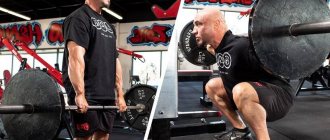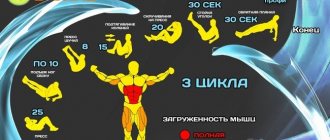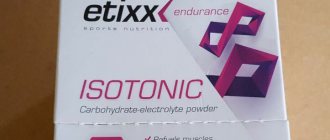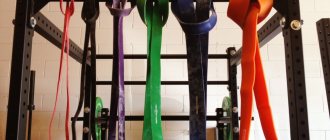When practicing any sport, the athlete’s attention will inevitably come to better recovery, optimal planning of mesocycles and getting into peak shape at the right time. All these tasks are related to the topic of supercompensation. This phase of increased performance when performing repeated work was first described by B.S. Gippenreiter in 1953.
Supercompensation plays a major role in the recovery process after training. During this period, there is an increase in sports results. The principle of supercompensation is applied in every sport, which will allow you to achieve the desired effect from training.
What is super compensation
Supercompensation is a period when already trained muscle tissue becomes powerful. The recovery process takes different periods of time. Muscle fibers are restored over a long period of time. When they increase, then muscle mass increases.
The speed of the onset of the supercompensation phase determines the optimal time when it is necessary to increase the sports load. By increasing the training load, not only muscle tissue increases, but also the body's endurance indicators increase.
Muscle growth or hypertrophy is an adaptation process of the body to changing conditions. The stress you experience during muscle training should increase with each physical activity.
To ensure this process, the muscles must be even stronger at the start of the next workout, when the muscle tissue has gained strength. During a planned workout, microtraumas occur in the muscle fibers, and during the recovery period the body begins to restore them.
Supercompensation principle
Recovery after training can be depicted as a graph (see Figure 01).
Rice. No. 1
At the first stage (training), the desired parameter (let’s assume glycogen) is reduced as much as possible. In the recovery phase (segment 2), it is compensated and reaches its initial level, after which the third phase begins, where the trained parameter exceeds its initial values. This phase is called supercompensation. It is transitory, i.e. is unstable and after the excess phase, the parameter returns to its original level, and if the recovery period is too long, the parameter will degrade (the so-called detraining). Therefore, the main point of building a training session in any sport is precisely to “catch” the supercompensation phase in order to conduct repeated training for the purpose of stable progress. (see figure 02).
Rice. No. 2
For example, if we consider the already mentioned glycogen, then the time of supercompensation for it is 48-72 hours. It is reasonable to repeat endurance training using glycogen as the main source of energy production during this time interval. This may be reasonable for sports such as long-distance running or, say, cycling, where glycogen levels determine athletic performance.
Three phases of recovery
According to Gippenreiter, there are three main phases of performance recovery (wiki) after performing the first work before fatigue:
Active recovery phase
The launch begins after training and continues for half an hour. At this moment, the body restores the normal function of the systems. The glycogen supply returns to normal, the heart rhythm is restored and the hormonal system is normalized.
Moderate recovery phase
During the launch of this phase, the body enhances the production of amino acids, enzymes, and restores electrolyte balance. The digestive system better absorbs the nutrients needed to build new body cells.
Supercompensation phase
It begins on the second day after the training process and lasts five days. At this time, you need to play sports, training your muscles, to increase mass.
Delayed recovery phase
The physical parameters of the body are restored to their original level. But provided that there was no physical activity in the supercompensation phase.
Bodymaster.ru recommends Training Plans:
At this moment it is necessary to train. If the moment of supercompensation is missed, then the indicators return to the previous level and the meaning of the training will no longer exist.
In order to consistently progress, it is necessary that each training session coincides with the peak of supercompensation. But this period is difficult to determine, since there are no identifiers in supercompensation.
It is different for each athlete and depends on age, level of physical fitness, and genetic predisposition.
In bodybuilding there is the concept of training frequency. To get into the compensation phase, you need to clearly draw up a training plan:
- Beginners are recommended to exercise 2 times a week.
- Athletes with more than a year of experience - 3 times a week.
- With more than three years of experience - 4 times a week.
- Professionals can exercise 6 or more times a week.
The right option would be for you to independently select the frequency of training based on how you feel. If training 3 or 4 times a week is tiring and there is no progress, then it is better to train twice a week, but more intensely.
Bodymaster.ru recommends Fitness Trainers:
Factors that influence the process of muscle tissue recovery: the level of stress during training, the athlete’s body weight, daily routine and physical fitness. The size of the muscle tissue group affects muscle recovery time.
How much stress a muscle receives during training will affect the recovery process.
The athlete’s weight also affects the recovery process; the larger the muscles, the slower they recover.
During the training process, energy is consumed and fatigue accumulates. After training, the recovery process begins, but it does not stand still, but lasts even longer than the initial level, this is supercompensation.
If training is missed during the supercompensation period, then a return to the original level begins and everything will have to start all over again.
An example of supercompensation for biceps training.
Let point “0” be maximum training, muscle fibers are already damaged, so the body, after completing the training process, will begin to restore damaged tissue. Approximately on the second day after recovery begins, supercompensation begins, lasting five days.
That is, if your training for a couple of muscle groups is 3 times a week, then training your biceps on Monday, the next workout should also be done on Monday. This is considered the best period for the recovery process. Then you can make progress from the training process.
Denis Borisov talks about this topic in detail in the following video.
Catching supercompensation means planning your workouts so that a new training process for a given muscle group occurs at the peak of this phase.
Depth of damage
The destruction of muscle tissue during training varies.
The deeper and stronger the damage, the longer the recovery process takes. The stronger the fatigue, the higher the supercompensation. The deeper the fatigue, the greater the risk of overloading muscle groups and the slower the recovery process.
It is important to remember that different functions of muscle tissue training have different time intervals for supercompensation.
Microcycles in supercompensation
They are used to quickly approach the intended goal, in this example, to increase muscle volume.
Typically a period of 3-4 weeks is used, during which the training is performed 3 to 6 times. To achieve maximum supercompensation, training must be exhaustive; overall performance will decrease during the day, but this is a temporary phenomenon. The suffering and muscle pain in the gym will pay off over time.
The easiest way to hypertrophy is to increase the working weight step by step. Thus, you will give the body an unusual load and it will be forced to adapt to it. This will continue until the body reaches its genetic limit, that is, you have reached an overload of your body.
Many people confuse the concepts of supercompensation and overtraining, the first means the stage of muscle fatigue, due to which their subsequent growth occurs, the second means complete exhaustion of the body, when the muscles are practically without energy, but they do not receive rest, and physical activity continues. The result of overtraining is stagnation. A striking example is the competition of biathletes, whose body requires several days of recovery at the finish line.
Trained functions and qualities
Main functions that need to be improved:
- Creatine phosphate restoration (2 to 10 minutes).
- Processing of lactic acid (from 1 minute to half an hour).
- Compensate for glycogen (1 - 3 days).
- Compensate for proteins (3 - 5 days).
In addition to these functions, it is important to restore the nervous and energy systems. Each of the above body functions is restored in a different time period; it is impossible to restore everything at the same time.
For example, after completing a workout, creatine phosphate will be restored first, but other functions will still be low. But when protein levels are restored, other functions will lose supercompensation. Therefore, different time frames for recovery are called heterochronism.
How to achieve heterochronism of simultaneous supercompensation
First, choose a function that takes longer to recover than others (contractile proteins) and focus only on it. It is necessary to simultaneously achieve improvement in all qualities.
Supercompensation of contractile proteins
By focusing on the longest-term function of recovery - the growth of muscle tissue cells, we know that they increase significantly. We will no longer be able to retrain other functions, because they are in the phase of loss of supercompensation and remain at the same level.
By training only the function of contractile proteins, muscle mass will not increase because there will not be enough energy.
Two stages of development of an athlete’s fitness:
- Using a training diary from the very beginning of your visit to the gym. Since at the initial stage the weight begins to grow, it is necessary to regularly progress the load.
- The concept of the principle of development of body functions, taking into account different periods for supercompensation.
Compensation in psychology
Compensation is the replenishment of real or imaginary shortcomings of a person by enhancing compensating qualities. By deficiency we mean a serious impairment of certain functions of our body.
What are the disadvantages?
- Visible injuries are injuries that are conspicuous to outsiders and which a person cannot hide. For example, absence of limbs, inoperable tumors, consequences of burns or other mechanical damage to the face and visible parts of the body. Since we form an opinion about ourselves by looking at the attitude of others towards us, the psyche of a person with a visible defect is subject to constant stress, especially if he lives in an intolerant society.
- Invisible – problems hidden in the body, such as congenital defects and dysfunction of certain organs. They can have a negative impact on a person’s psyche, as they deprive him of the opportunity to live a full life.
- Imaginary - contrived shortcomings that are the result of childhood psychotrauma. For example, a person is confident in his ugliness, although outwardly he is no different from other people.
In all these cases, a person's shortcomings require compensation. Compensating can be not only qualities directly related to a person’s disability (for example, a Paralympic runner without legs), but also alternative, substitute aspirations (a deaf artist or a blind musician). The understanding of compensation was first introduced by Sigmund Freud, and it became the fundamental understanding of the term “hypercompensation” in later psychology. In particular, compensation according to Adler includes the basic concepts of Freudian compensation, but is understood as a life strategy developed by the individual.
We can see a clear example of compensation at the Paralympics, where people with disabilities demonstrate strength and agility. Compensation in this case performs the function of replacing physical deficiencies that interfere in everyday life with the manifestation of physical strength in competitions. To achieve a sense of their worth, people with real problems need to put in a lot of effort, which makes their actions heroic in the eyes of society. In this case, compensation is approval from other people, their recognition.
How to recover properly
The recovery process goes through four phases:
- Fast recovery. ends thirty minutes after the end of the training process. It is important to replenish glucose and mineral levels. After training, drink mineral water without adding gas.
- Slow recovery. When nutrient levels are replenished, the body repairs damaged muscle fibers. At the same time, protein synthesis begins, so food must contain the required amount of amino acids.
- Supercompensation is an important stage in achieving results. The body begins to intensively consume carbohydrates and amino acids in order to restore the required amount of muscle tissue and provide the body with energy for intense exercise. At this stage the next training process needs to be carried out. After the supercompensation stage, the body becomes stronger to withstand a powerful load.
- Delayed recovery. It begins immediately after the end of supercompensation, when you missed your workout. Therefore, you need to strictly follow the training schedule, otherwise progress will slow down. The point of this recovery stage is that the body is restored to its usual state, which was before the gym.
How to catch
The difficulty lies in the fact that each person’s body is individual, and the listed phases occur at different speeds and frequencies, and last for different times. In order to say with approximate accuracy when a person will enter the supercompensation phase, it is necessary to observe him for a long time, track his periods of fatigue and activity, and develop an individual training schedule.
Everyone's physical endurance is different. It depends on innate natural data, state of health, and well-being. A positive effect is achievable only with proper distribution of the load. The overload required for the onset of over-recovery should not be confused with complete overload and exhaustion of the body.
If you train hard, you can only get a negative effect, the opposite of what you expected. After training with increased load, you feel exhausted and weak for several days, during which recovery and then super-recovery occurs.
After an overload workout, muscle weakness and pain can last for weeks. If you practice overload for a long time, the body will become completely exhausted, from which it will take months to recover.
A proven way to determine your peak fitness level is to monitor how you feel. If you feel tired and weak, muscle pain means you have not recovered. Count how many days you felt this way.
The most convenient way is to keep a notebook and write down the results. As soon as the muscle pain has passed and you feel a surge of strength, record it again. What date did this happen and how long did it last? Such observations need to be carried out for a long time, at least a month. A few months is better.
During periods of illness, it is better to reduce classes or cancel them altogether, and not take into account the indicators, since they are not objective. Also, it is better to exercise with a uniform load. Then it is possible to change it (increase or decrease).
Recovery after a light load will be short, and after a moderate load it will be longer. Based on this, the surge of strength will come at different times. After the specified observation period, you can draw conclusions about how many days you need to recover and when the supercompensation phase begins.
! Remember that everything needs moderation. It is the correct calculation of the load, and not its constant excess, that will allow you to achieve a good result.
About Tapering
Tapering is a time period before a competition, when the load is projected in such a way as to eliminate the stress accumulated during the preparation period and ensure access to supercompensation in the required time period.
In other words, a sustained reduction in physical activity at a specific point in time before a competition reduces the resulting stress of everyday training and improves athletic performance.
Energy is restored and toxins are removed from the body.
As a result of tapering, the body's capabilities increase, despite the tedious process. In this regard, the level of sports achievements increases.
Ways to speed up recovery
After the workout, there is pain and a feeling of congestion in the muscles. This is due to the accumulation of lactic acid in muscle tissue.
This is a breakdown product and in order to remove it from the body as quickly as possible, it is necessary to speed up recovery.
It can be passive, when you rest after training, or active. Active recovery includes massage and light exercise.











